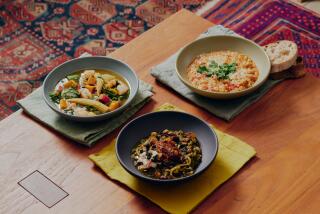China: Its Gastronomic Landscape : Rustic Hot Pots : Easy dishes: Little known in the West, these winter warmers are as much a part of Chinese cuisine as the quick stir fry--which they probably antedate.
- Share via
Winter in China is the season for hearty clay pot casseroles. Brought to the table bubbling in their rustic containers, they cheer the spirit as well as the body.
When you lift the lid, the steam slowly clears and reveals an array of foods that may seem startling to the Western eye. Fish and seafood might mingle with meat--lamb or beef or pork--along with bean curd, vegetables and several aromatic spices. A mellow sauce, often enhanced with a generous dash of wine, forms through long, slow simmering.
These richly flavored hot pots are not well known in the West, but they are as much a part of Chinese cuisine as the quick stir fry and probably antedate that technique.
It’s an easy style of cooking, especially if you’re entertaining. There’s no last minute chopping or sauteing of ingredients. And unlike fast wok dishes in which timing is crucial, you don’t have to worry about burning and overcooking.
The new VBC Seafood Restaurant in Chinatown lists a dozen hot pot specialties, including dried shrimp with bean threads, catfish with garlic, and roast pork with oysters, fried bean curd and lettuce. Lake Spring Cuisine in Monterey Park serves a Shanghainese casserole dominated by an enormous fish head. Sliced bean curd, black mushrooms, lots of whole garlic cloves and chewy, gelatinous rice sheets join the fish in a strongly seasoned sauce.
Peter Law, chef at the Wilshire-district restaurant Chinese Expression, combines fish with fried tofu, Virginia ham, napa cabbage and shiitake mushrooms. Hoisin and oyster sauces accent the seafood flavor. The liquid in which the mixture simmers is oyster juice (chicken broth is an acceptable substitute) and wine.
Law is from Hong Kong, a center of Cantonese cookery, and makes a spare-rib casserole that reflects the Western influence on that cuisine. The ribs are cut into small pieces and cooked with curry powder, mustard, honey, tomato juice, soy sauce and a splash of red wine. The taste is like American barbecue sauce.
Northern Chinese prize lamb casseroles during their frigid winters. “In Chinese herbal medicine, lamb is very nutritious,” says Susie Teng, who owns Chinese Expression. “It helps generate body heat so you don’t get chilled so easily.” Although accustomed to milder weather, the Cantonese also seek out lamb during cold months. “They know what is good for the body,” Teng says.
Law makes a lamb casserole that incorporates the meaty tastes of dried bean curd sticks and black mushrooms. Teng’s variation is to add a few mint leaves. And although it’s not authentic procedure, she adds a stalk of lemon grass when making Law’s fish casserole. Those who like spicy flavors can add 1/4 teaspoon hot bean paste to each dish, she says.
Traditional clay pots are stocked in Chinese shops, but any heavy casserole may be used for these dishes. The Chinese pots can withstand direct heat if carefully handled. They should not be heated without liquid or set on a cold surface when hot. And they may need the protection of a heat diffuser if used on an electric stove.
Although simmering in a clay pot supposedly contributes to the flavor, a safer method suggested by Teng is to cook the ingredients in a wok and turn them into a heated casserole for serving.
The following recipes from Chinese Expression require some specialized ingredients readily available in Chinese markets. Bean curd sticks are just that--light brown sticks of dried bean curd “skin.” You’ll find them where dried ingredients are displayed. Packages containing small squares of fried bean curd are in the refrigerated section along with other bean curd products. Or you may substitute two slices regular bean curd, cut into 1 1/2-inch squares and deep fried until browned. Virginia ham can be purchased in the meat section of well-stocked Chinese markets, and Teng recommends buying spare ribs for the pork casserole in Chinese markets too because they tend to be meatier.
SPARE RIBS IN SPICY
CURRY SAUCE
2 tablespoons oil
2 or 3 cloves garlic, crushed
1 teaspoon minced ginger root
2 teaspoons curry powder
2 pounds meaty pork spare ribs, cut in 1 1/2-inch lengths
1 quart chicken broth, homemade or canned
1/3 cup tomato juice, fresh or canned
3 tablespoons soy sauce
2 tablespoons honey
1 tablespoon prepared Chinese hot mustard
1 small onion, chopped
1 large shallot, chopped
2 tablespoons red wine
1/4 cup chopped green onions
Heat oil in wok over medium-high heat. Add garlic, ginger and curry powder and stir until fragrant. Add ribs and stir until lightly browned. Add chicken broth, tomato juice, soy sauce, honey, mustard, onion and shallot.
Bring to boil, lower heat, cover and simmer 1 1/2 hours. Uncover during last 15 minutes to reduce liquid, if necessary. When done, stir in red wine. Turn into casserole and sprinkle with green onions. Makes 3 to 4 servings.
PETER LAW’S
LAMB POT
3 dried bean curd sticks
5 dried shiitake mushrooms
2 tablespoons oil
2 tablespoons minced ginger root
4 cloves garlic, crushed
6 pieces star anise
1 1/2 pounds boneless lean lamb meat, cut in 1 1/2-inch chunks
6 shallots, peeled and halved
1 large bamboo shoot, cut in 1 1/2-inch chunks
1 cup dry Sherry
1/4 cup soy sauce
1 tablespoon honey
1 teaspoon Chinese chile sauce with garlic
6 cups beef broth
Dash white pepper
3 to 5 mint leaves
Break dried bean curd skin into smaller pieces. Cover with cold water and let stand until softened. Place black mushrooms in bowl of cold water until softened, drain and cut each in half. Set aside.
Heat oil in wok over medium-high heat. Add ginger root and garlic and stir until fragrant. Add star anise and lamb and cook and stir until lamb is lightly browned. Add 3 shallots, bamboo shoot, Sherry, soy sauce, honey and chile sauce. Add enough of broth to cover meat but not too deeply.
Bring to boil, reduce heat, cover and simmer 1 hour. Add bean curd pieces, mushrooms, remaining 3 shallots, white pepper and mint leaves. Cover and simmer 1/2 hour longer. Makes 4 servings.
CHINESE EXPRESSION
FISH POT
3 green onions
3 tablespoons oil
1 1/2 teaspoons minced garlic
1 1/2 teaspoons minced ginger root
1 pound cod or other firm white fish fillets, cut in 2-inch pieces
1 cup dry Sherry
3 cups chicken broth
2 tablespoons soy sauce
1 tablespoon oyster sauce
1 tablespoon hoisin sauce
1 tablespoon sugar
6 dried shiitake mushrooms, soaked and sliced
8 leaves napa cabbage, cut in 2-inch pieces
1/2 cup Virginia ham cut in 1/2-inch cubes or 1/2 cup pork cut in thin strips
1 stalk lemon grass, solid portion only, cut in 1-inch pieces
1 (6-ounce) package fried bean curd squares
Cut leafy tops of green onions in 1-inch pieces, shred lengthwise and set aside. Cut bottom portion in 2-inch pieces.
To prevent fish from breaking up, spray wok with non-stick vegetable coating. Then add 2 tablespoons oil and heat over medium-high heat. Add garlic, ginger and green onion pieces and stir-fry until fragrant. Push mixture to one side.
Add remaining 1 tablespoon oil to wok. Carefully place fish pieces in wok and cook lightly, turning gently so as not to break fish. Add Sherry. Lift fish from pan and set aside.
Add chicken broth, 1 tablespoon soy sauce, oyster sauce, hoisin sauce, sugar, mushrooms, cabbage, ham and lemon grass. Bring to boil and boil gently, uncovered, 10 minutes.
Cut 6 squares fried bean curd in half, reserving remaining 3 squares for another use. Return fish to pan. Add bean curd and remaining 1 tablespoon soy sauce and cook over medium heat, uncovered, 3 minutes. Carefully ladle contents of wok into heated casserole and sprinkle with shredded green onion tops. Makes 4 servings.
More to Read
Eat your way across L.A.
Get our weekly Tasting Notes newsletter for reviews, news and more.
You may occasionally receive promotional content from the Los Angeles Times.










